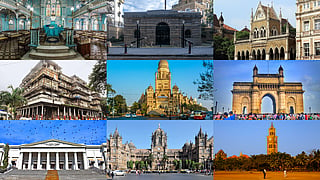
Whether it’s the grand Gateway of India or the charming Esplanade Mansion, Maximum City's structures are a testament to its vibrant past and dynamic present. So on this World Tourism Day, let's delve deeper into Mumbai's architectural splendour with these 9 stunning marvels.
From colonial-era gems to modern masterpieces, discover the city’s rich tapestry of design and history.
The David Sassoon Library is a Victorian gem in Kala Ghoda, showcasing Mumbai’s unique Venetian-Gothic blend. Established in 1870, this architectural marvel, funded by the Jewish philanthropist David Sassoon, boasts a striking façade, intricate Minton tiles, and a grand interior with tall ceilings and stained glass. It’s a must-visit for architecture enthusiasts eager to explore Mumbai's colonial charm.
Located at the entrance of Mumbai's Ballard Estate, the Ballard Bunder Gatehouse is a hidden architectural gem, often overlooked in the city's hustle. Built in 1911 to honour King George V and Queen Mary, this Indo-Saracenic marvel features intricate carvings and majestic arches. Serving as a key entry point to the Ballard Bunder and a sea front access until 1950, it reflects a charming piece of Mumbai's colonial past.
Located in Kala Ghoda, the Keneseth Eliyahoo Synagogue is Mumbai's sky blue gem, built in 1884. This second-oldest Sephardic synagogue boasts a captivating blend of European and Indian styles with stunning stained glass windows and intricate chandeliers. Funded by the philanthropic Sassoon family and designed by the architects Gostling and Morris, it beautifully reflects Mumbai's rich cultural tapestry.
Mumbai's iconic Asiatic Society Library, founded by Sir James Mackintosh, is a stunning example of Neo-classical architecture. Its majestic white facade, lined columns, and grand steps exude elegance, drawing in visitors and photographers alike. Designed by Colonel Thomas Cowper, the library’s Grecian portico and eight Doric pillars add to its charm.
Mumbai's iconic Chhatrapati Shivaji Maharaj Terminus (CSMT) is a blend of Indian and Victorian Gothic Revival architecture. Built in 1887 by British architect Frederick William Stevens, this stunning railway station features intricate carvings, stained glass windows, and domes that showcase Indo- Saracenic elements. Originally known as Victoria terminus, CSMT is a testament to Mumbai’s colonial past and architectural grandeur.
The Rajabai Clock Tower, standing tall on the University of Mumbai campus, is a Neo-Gothic marvel built in the 19th century. Designed by Sir George Gilbert Scott and inspired by London's Big Ben, this iconic structure features pointed arches, stained glass windows, and intricate carvings. Although access is restricted, its beauty and historical significance can still be admired from afar, making it a standout piece of Mumbai’s colonial architecture.
The BMC Building, or Municipal Corporation Building, is a striking example of colonial architecture in Mumbai. Completed in 1893, this architectural gem showcases a blend of Venetian Gothic and Indo-Saracenic styles, designed by Frederick William Stevens. With its grand domes, minarets, and turrets, it offers a glimpse into Mumbai’s rich history.
The Gateway of India, overlooking the stunning Arabian Sea, is a must-see landmark in Mumbai. Completed in 1924, this iconic structure welcomes visitors to the “city of seven islands” with its striking Indo-Saracenic architecture. Featuring intricate carvings, yellow basalt, and a grand dome flanked by four turrets, it blends Indian and Islamic styles with British elegance, reflecting Mumbai's rich history and charm.
Esplanade Mansion, once Watson’s Hotel, stands as Asia’s oldest surviving cast-iron building. Nestled near Kala Ghoda, this architectural gem from 1885 showcases a unique skeletal iron framework, echoing 19th-century European design. Commissioned by Jamsetji Tata and designed by James Morris, it features a grand central courtyard and classical style, reflecting Mumbai's rich architectural heritage despite its current state of disrepair.
To get all the latest content, download our mobile application. Available for both iOS & Android devices.